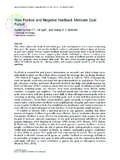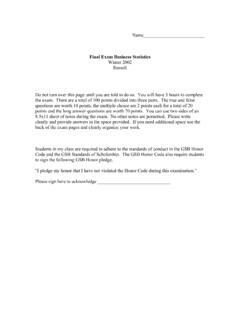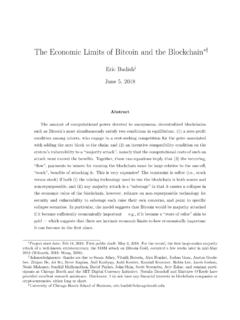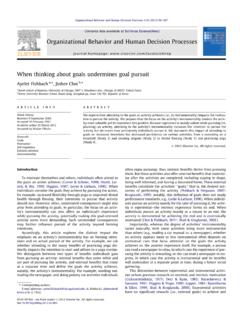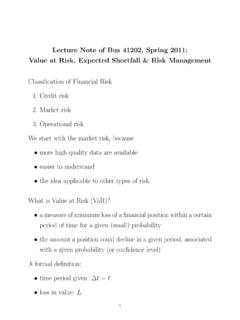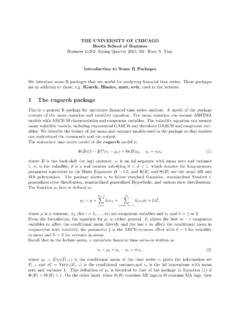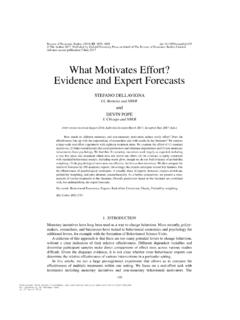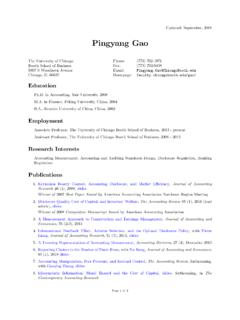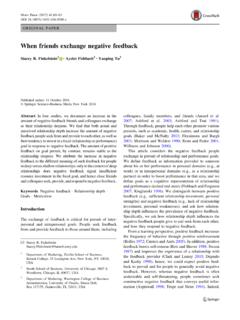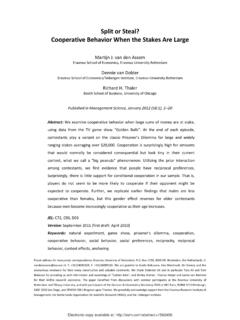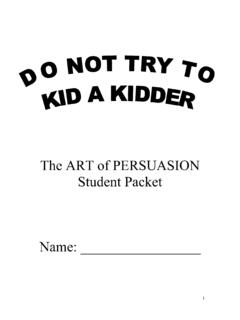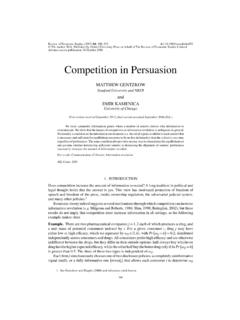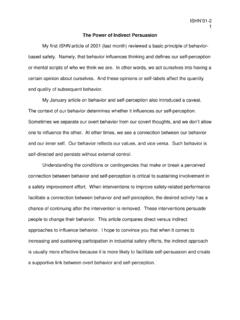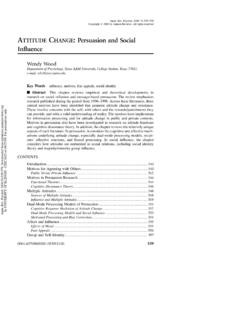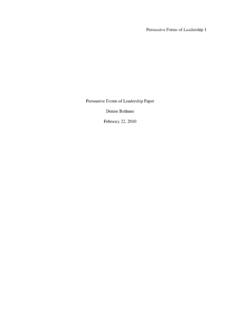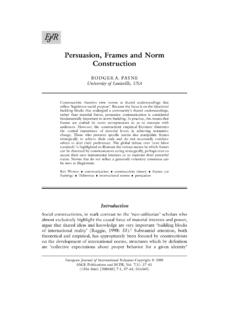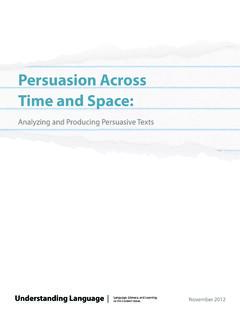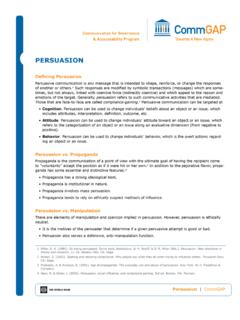Transcription of Bayesian Persuasion - Booth School of Business
1 American Economic Review 101 (October 2011): 2590 2615 one person, call him Sender, wishes to persuade another, call her Receiver, to change her action. If Receiver is a rational Bayesian , can Sender per-suade her to take an action he would prefer over the action she was originally going to take? If Receiver understands that Sender chose what information to convey with the intent of manipulating her action for his own benefit, can Sender still gain from Persuasion ? If so, what is the optimal way to persuade?These questions are of substantial economic importance. As Donald McCloskey and Arjo Klamer (1995) emphasize, attempts at Persuasion command a sizable share of our resources. Persuasion , as we will define it below, plays an important role in advertising, courts, lobbying, financial disclosure, and political campaigns, among many other economic the example of a prosecutor trying to convince a judge that a defendant is guilty. When the defendant is indeed guilty, revealing the facts of the case will tend to help the prosecutor s case.
2 When the defendant is innocent, revealing facts will tend to hurt the prosecutor s case. Can the prosecutor structure his arguments, selection of evidence, etc. so as to increase the probability of conviction by a rational judge on average? Perhaps surprisingly, the answer to this question is yes. Bayes s Law restricts the expectation of posterior beliefs but puts no other constraints on Bayesian Persuasion By Emir Kamenica and Matthew Gentzkow*When is it possible for one person to persuade another to change her action? We consider a symmetric information model where a sender chooses a signal to reveal to a receiver, who then takes a noncon-tractible action that affects the welfare of both players. We derive necessary and sufficient conditions for the existence of a signal that strictly benefits the sender. We characterize sender-optimal signals. We examine comparative statics with respect to the alignment of the sender s and the receiver s preferences. Finally, we apply our results to Persuasion by litigators, lobbyists, and salespeople.
3 (JEL D72, D82, D83, K40, M31)* Kamenica: University of Chicago Booth School of Business , 5807 South Woodlawn Avenue, Office 518, Chicago, IL 60637 (e-mail: Gentzkow: University of Chicago Booth School of Business , 5807 South Woodlawn Avenue, Office 514, Chicago, IL 60637 (e-mail: We thank Richard Holden for many important contributions to this paper. We would also like to thank Eric Budish, Wouter Dessein, Navin Kartik, Canice Prendergast, Maxwell Stinchcombe, Lars Stole and participants at numerous seminars for helpful comments. This work is supported by the Initiative on Global Markets, the George J. Stigler Center for the Study of the Economy and the State, the James S. Kemper Foundation Faculty Research Fund, the Centel Foundation/Robert P. Reuss Faculty Research Fund, and the Neubauer Family Foundation, all at the University of Chicago Booth School of Business . To view additional materials, visit the article page at And gEntzkOW: Bayesian pERsuAsiOnVOL.))
4 101 nO. 6their distribution. Therefore, so long as the judge s action is not linear in her beliefs, the prosecutor may benefit from make this concrete, suppose the judge (Receiver) must choose one of two actions: to acquit or convict a defendant. There are two states of the world: the defendant is either guilty or innocent. The judge gets utility 1 for choosing the just action (convict when guilty and acquit when innocent) and utility 0 for choosing the unjust action (convict when innocent and acquit when guilty). The prosecutor (Sender) gets utility 1 if the judge convicts and utility 0 if the judge acquits, regardless of the state. The prosecutor and the judge share a prior belief Pr (guilty) = prosecutor conducts an investigation and is required by law to report its full outcome. We can think of the choice of the investigation as consisting of the deci-sions on whom to subpoena, what forensic tests to conduct, what questions to ask an expert witness, etc.
5 We formalize an investigation as distributions ( | guilty) and ( | innocent) on some set of signal realizations. The prosecutor chooses and must honestly report the signal realization to the there is no communication (or equivalently, if is completely uninformative), the judge always acquits because guilt is less likely than innocence under her prior. If the prosecutor chooses a fully informative investigation, one that leaves no uncer-tainty about the state, the judge convicts 30 percent of the time. The prosecutor can do better, however. As we show below, his uniquely optimal investigation is a binary signal:(1) (i | innocent) = 4 _ 7 (i | guilty) = 0 (g | innocent) = 3 _ 7 (g | guilty) = leads the judge to convict with probability 60 percent. Note that the judge knows 70 percent of defendants are innocent, yet she convicts 60 percent of them! She does so even though she is fully aware that the investigation was designed to maximize the probability of this paper, we study the general problem of persuading a rational agent by controlling her informational environment.
6 We consider a symmetric information setting with an arbitrary state space and action space, an arbitrary prior, and arbi-trary state-dependent preferences for both Sender and Receiver. Sender chooses an informative signal about the state of the world, Receiver observes a realization from this signal, and then she takes an action. Throughout the analysis, we prohibit Sender from making transfers or affecting Receiver s payoffs in any way. We focus on two questions: (i) when does there exist a signal that strictly benefits Sender, and (ii) what is an optimal signal from Sender s perspective?A key assumption of our model is that Sender cannot distort or conceal informa-tion once the signal realization is known. This allows us to abstract from the incen-tive compatibility issues that are the focus of much of the previous literature on strategic communication. We discuss the precise meaning of this assumption and the settings where it is likely to apply when we introduce the general model begin by establishing a result that simplifies our analysis.
7 We show that we can reexpress the problem of choosing an optimal signal as a search over distributions of 2592tHE AmERicAn EcOnOmic REViEWOctOBER 2011posteriors subject to the constraint that the expected posterior is equal to the prior. This reformulation of Sender s problem provides a useful geometric approach to deriving the optimal does there exist a signal that strictly benefits Sender? Consider why the prosecutor in the example benefits from the opportunity to provide information to the judge. Since the judge is rational, providing information must sometimes make her more convinced and sometimes less convinced that the defendant is guilty. The former will strictly improve the prosecutor s payoff if the information is strong enough to induce conviction. The latter, however, will not reduce the prosecutor s payoff, since the judge already acquits the defendant by default. The net effect is to increase the prosecutor s payoff in expectation.
8 We show that in general Sender benefits from Persuasion whenever (i) Receiver does not take Sender s preferred action by default (in a sense we make precise below) and (ii) Receiver s action is constant in some neighborhood of beliefs around the prior. When these conditions hold, Sender can benefit by sending a signal that induces a better action with posi-tive probability and balances this with a worse belief that leaves Receiver s action unchanged. We also show that whether Sender benefits from Persuasion depends in a natural way on the concavity or convexity of Sender s payoff as a function of Receiver s next turn to studying optimal signals. We use tools from convex analysis to characterize the optimal signal for any given set of preferences and initial beliefs. We show that no disclosure of information is optimal when Sender s payoff is con-cave in Receiver s beliefs, and full disclosure is optimal when Sender s payoff is convex in Receiver s then generalize two important properties of the optimal signal in the example above.
9 Notice, first, that when the judge chooses the prosecutor s least-preferred action (acquit), she is certain of the state. That is, she never acquits guilty defen-dants. Otherwise, we would have (i | guilty) > 0. But then the prosecutor could increase his payoff by decreasing (i | guilty) and increasing (g | guilty) ; this would strictly increase the probability of g and would only increase the willingness of the judge to convict when she sees g. We establish that, in general, whenever Receiver takes Sender s least-preferred action, she knows with certainty that the state is one where this action is uniquely , notice that when the judge convicts, she is exactly indifferent between convicting and acquitting. If she strictly preferred to convict upon seeing g, the pros-ecutor could increase his payoff by slightly decreasing (i | innocent) and increasing (g | innocent) ; this would increase the probability of g and leave the judge s opti-mal action given the message unchanged, thus increasing the probability of convic-tion.
10 We show that, in general, whenever Receiver has an interior posterior, she is effectively indifferent between two also examine how the extent of information transmission and Sender s gain from Persuasion depend on the alignment of Sender s and Receiver s preferences. In contrast to previous work on strategic communication, we find that making prefer-ences more aligned can reduce the extent of communication in next apply our results to two examples. First, we examine the type of studies that a lobbying group might fund so as to influence a benevolent politician. Then, we analyze a seller s provision of free trials or other information to potential consumers. 2593kAmEnicA And gEntzkOW: Bayesian pERsuAsiOnVOL . 101 nO. 6In the final section of the paper, we discuss extensions of our results to settings where Receiver has private information and where there are multiple observation that Bayesian updating only restricts the expectation of posteriors has been made before and has been utilized in a variety of contexts.
